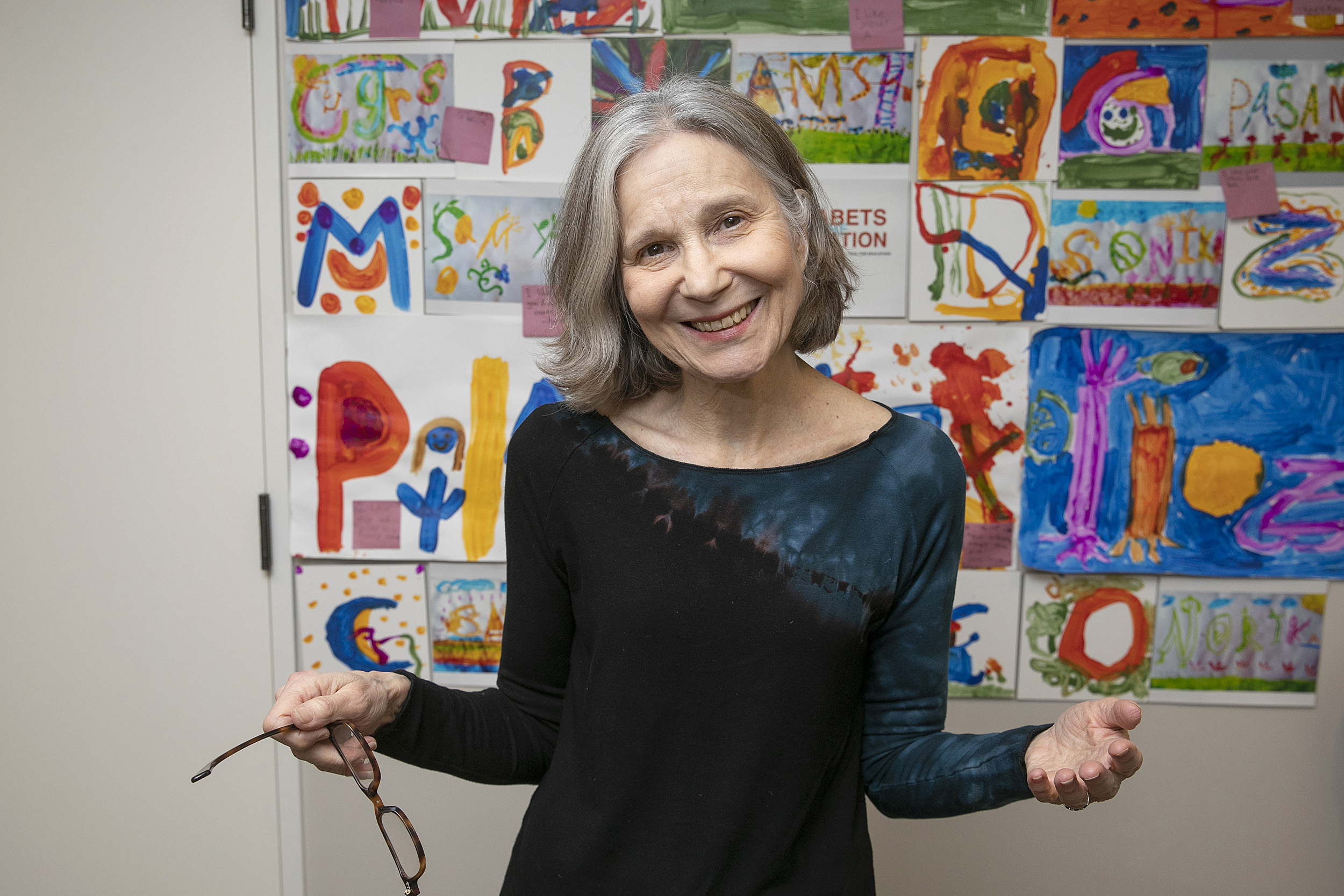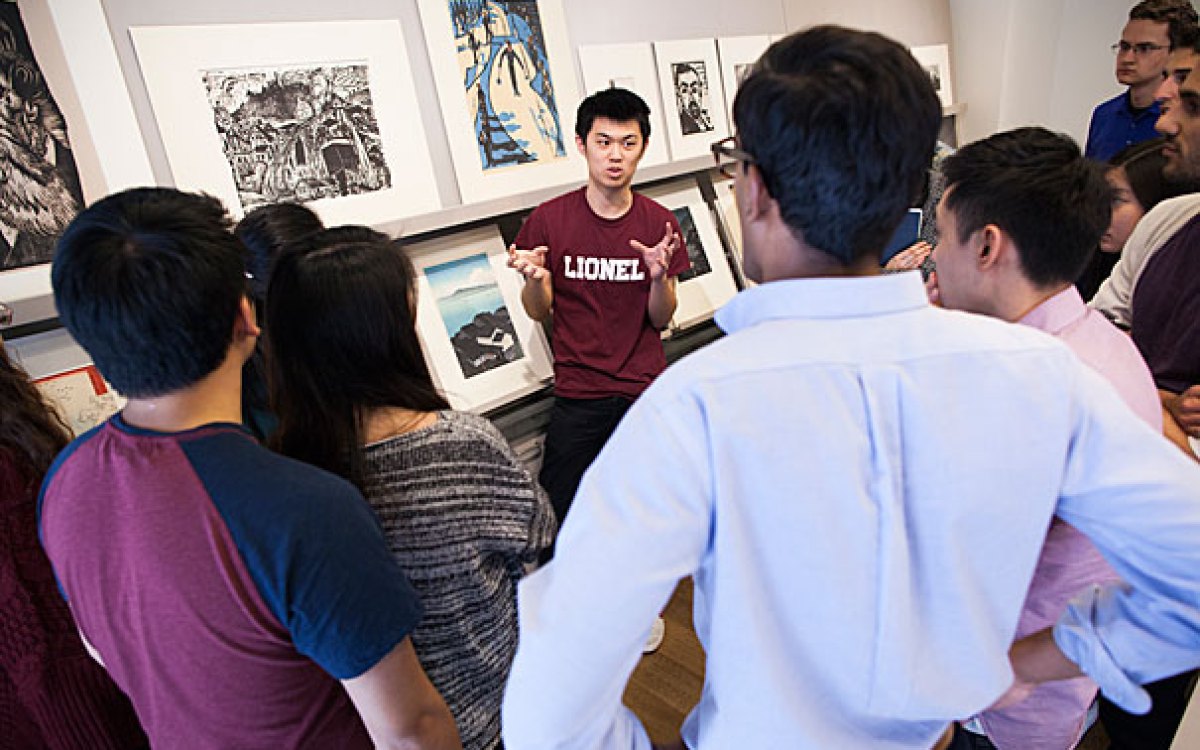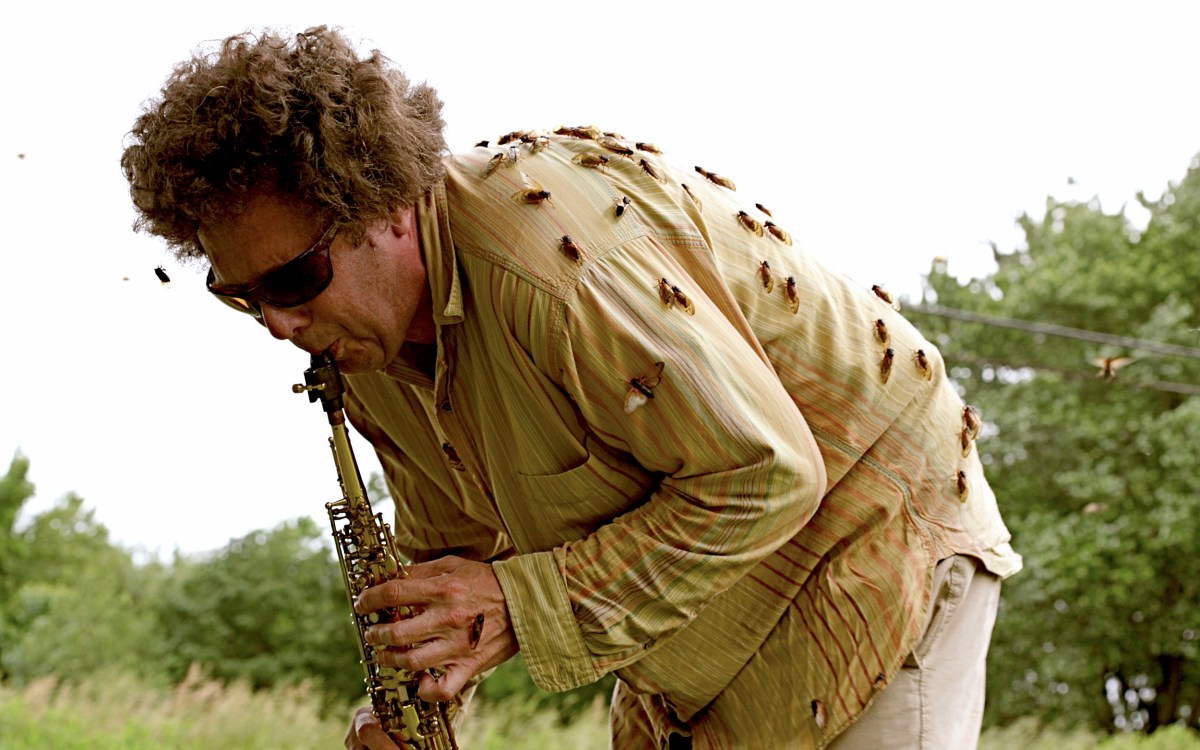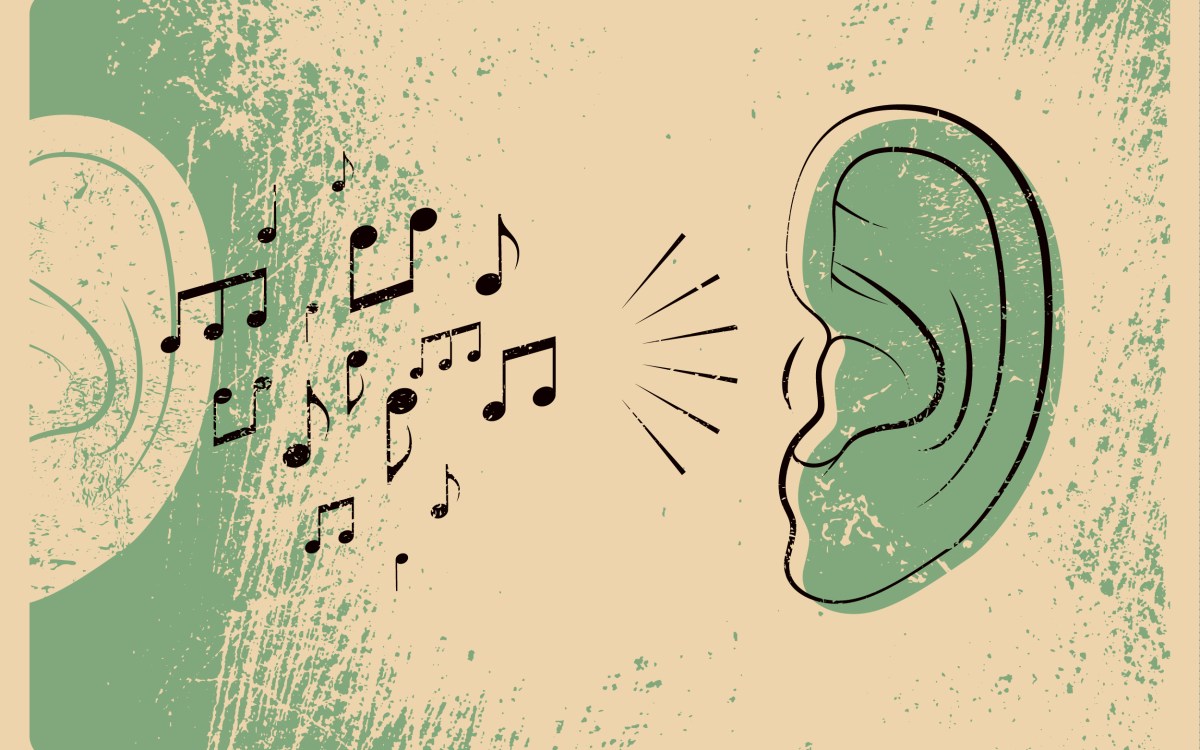
Project Zero senior researcher Ellen Winner’s latest book, “How Art Works: A Psychological Exploration,” is based on years of research at Harvard and Boston College.
Jon Chase/Harvard Staff Photographer
The aesthetic attitude to art
Harvard researcher’s latest book explores how and why we react to it
Ellen Winner ’69, Ph.D. ’78, BI ’99 concentrated in English at Radcliffe, but she’d always planned to be an artist. She attended the School of the Museum of Fine Arts after college to study painting but soon realized “it was not the life I wanted.” Instead, Winner turned her focus to psychology, earning her doctorate at Harvard.
A summer job listing at the University’s career office led her to the Harvard Graduate School of Education’s Project Zero, where she interviewed with her future husband, Howard Gardner — currently the John H. and Elisabeth A. Hobbs Professor of Cognition and the senior director of the project — and took a two-year position researching the psychology of art. For her doctoral degree at the Graduate School of Arts and Sciences, Winner studied developmental psychology. She is currently a senior research associate at Project Zero and a professor of psychology at Boston College, where she founded and directs the Arts and Mind Lab, which focuses on cognition in the arts in typical and gifted children as well as adults. Her latest book, “How Art Works: A Psychological Exploration,” is based on years of research at both Harvard and BC, and looks at art through psychological and philosophical lenses. The Gazette spoke with her recently about her findings.
Q&A
Ellen Winner
GAZETTE: Why do we need art?
WINNER: It’s interesting to note that the arts have been with us since the earliest humans — long before the sciences — and no one has ever discovered a culture without one or more forms of art. Evolutionary psychologists have postulated various ways in which natural selection could explain why we have art. For example, fiction allows us to safely practice interpersonal relationships and those with strong interpersonal skills are more likely to mate and spread their genes. Sexual selection could also be at work: Artists might attract mates because artistic talent might signal high reproductive fitness. There is no way of testing such claims, though. My best guess is that art itself is not a direct product of natural selection, but is a byproduct of our bigger brains — which themselves evolved for survival reasons. Art is just something we cannot help but do. While we may not need art to survive, our lives would be entirely different without it. The arts are a way of making sense of and understanding ourselves and others, a form of meaning-making just as important as are the sciences.
GAZETTE: In your book you suggest that people have stronger emotional reactions to music than to the visual arts. Why?
WINNER: Of course, we do respond emotionally to both music and visual art, but people report stronger emotional responses to music. I have asked my students to look at a painting for one uninterrupted hour and write down everything they are seeing and thinking (inspired by Jennifer Roberts, art historian at Harvard, who asked her students to do this for three hours). The students wrote about all of the things they started to notice, but strikingly absent was any mention of emotions. They reported being mesmerized by the experience but no one talked about being close to tears, something people often report with music.
There seem to be several reasons for music eliciting stronger emotional reactions than the visual arts. The experience of music unrolls over time, and often quite a long time. A work of visual art can be perceived at a glance and people typically spend very little time with each work of art they encounter in a museum. We can turn away from a painting, but we can’t turn away from music, and so a painting doesn’t envelop us in the same way music does. In addition, music, but not visual art, makes us feel like moving, and moving to music intensifies the emotional reaction. One of the most powerful explanations for the emotional power of music has to do with the fact that the same properties that universally convey emotion in the voice (tempo, volume, regularity, etc.) also convey emotion in music. Thus, for example, a slow tempo in speech and music is typically perceived as sad, a loud and uneven tempo as agitated, etc. The visual arts do not have such a connection to emotion. Movies may be the most powerful art form in eliciting emotion since they unfold over time, tell a story, and of course include music.
GAZETTE: Can you talk more about your studies involving a person’s ability to distinguish between artwork by an abstract master and a painting done by a monkey with a paintbrush and palette?
WINNER: We were interested in the often-heard claim about abstract art that, “My kid could have done that.” We wanted to find out whether people really cannot tell the difference between preschool art and the works of great abstract expressionists like Hans Hofmann or Willem de Kooning. We also threw animal art into the mix: Chimps and monkeys and elephants have been given paint brushes laden with paint, and they often make charming, childlike markings — with the experimenter taking the paper away when the experimenter deems it “finished.” My former doctoral student Angelina Hawley-Dolan created 30 pairs of paintings in which she matched works by abstract expressionists with works by children and animals — matched so that the members of each pair were superficially similar in color and composition and kinds of brush strokes. In a series of studies, we showed people these pairs and asked them to decide which work was better, which they liked more, and which was done by an artist rather than a child or animal. Sometimes we unpaired the works and asked people the same questions when they were presented one at a time.
“When you hear someone say, ‘My kid could have done that,’ you can say, ‘Not so!’”
We found in each study that people unschooled in abstract expressionism selected the artists’ works as better and more liked, identified them as by artists rather than animals and children, and did this at a rate significantly above chance. Even when we tried to trick people (mislabeling the child work as by an artist and the artist work as by a child or animal), people recognized the actual artist’s work as the better work of art, uninfluenced by the false label. In addition, working with a computer scientist, we showed that a deep learning algorithm was able to learn to differentiate works by artists versus by children and animals, and succeeded at the same rate of correctness as did humans. And so, when you hear someone say, “My kid could have done that,” you can say, “Not so!”
GAZETTE: What do you think was going on?
WINNER: To get at this we asked another group of people to look at each of the 60 paintings, 30 by the preschoolers and animals and 30 by the great artists, one at a time and randomly ordered. We asked them to rate each work in terms of how intentional it looked, and how much visual structure they saw. The works by the artists were on average rated as more intentional and higher in visual structure. When we asked people why they thought the artists’ paintings were better works of art, they gave us mentalistic answers, saying things like, “It looks more planned” or, “It looks more thought-out.” So, it appears that we make a clear discrimination: We perceive artists’ abstract paintings as highly planned, and those by children and animals as unplanned and somewhat random. Tellingly, we found that some paintings by artists were incorrectly identified as by children or animals, and these turned out to be the ones that had been rated as low in intentionality and structure. Our conclusion is that people see more in abstract art than they think they see. They can see the mind behind the work.
GAZETTE: You mention that art that evokes negative emotions can also be positive thing. Can you explain?
WINNER: We gravitate toward art that depicts tragic or horrifying events (think of paintings by Hieronymus Bosch or Lucian Freud, whose portraits are often distorted and somewhat grotesque); we flock to sad or suspenseful or horrifying movies or plays or novels; we listen to music that conveys grief. Given how we strive to avoid feelings of sorrow and terror and horror in our personal lives, this presents us with a paradox — one that interested philosophers such as Aristotle, Immanuel Kant, and David Hume. This puzzle is resolved by studies showing that when we view something as art, any negative feelings about the content are matched by positive ones. For instance, one study demonstrated that presenting photographs of disgusting things like rotting food either as art photography or illustrations to teach people about hygiene led to different reactions: Those who viewed the images as art reported positive feelings along with the negative ones; those who viewed them as hygiene illustrations reported only negative feelings. Other studies have shown that people report being highly moved by art with negative content, and the experience of feeling moved combines negative affect with an equal level of positive affect. In short, we can allow ourselves to be moved by tragedy and horror in art because it is not about us; we have entered a fictional world of virtual reality. And the experience of being moved by such works is not only pleasurable, but can also be highly meaningful as we reflect on the nature of our feelings.
GAZETTE: You also explore how theater can inspire empathy.
WINNER: We often hear that the arts are good for our children because they make them more empathetic. But this is the kind of claim that ought to be closely examined. Is there truth to this claim, and if so does it apply to all the arts? My former doctoral student Thalia Goldstein, now an assistant professor at George Mason University, reasoned that it is in acting that empathy is most likely to be nurtured. She directed a longitudinal study of children and adolescents involved in acting classes over the course of a year, comparing them to students taking visual arts classes. At the end of the year, the acting students in both age groups had gained more than the visual arts students on a self-report empathy scale, and the adolescent acting students had also grown stronger in perspective-taking. These results have the plausible explanation that acting entails stepping into different characters’ shoes over and over, practicing seeing the world from another’s eyes.
There is still a lot we don’t know about the arts and empathy. Does reading fiction or watching a drama on stage have the same effect as enacting fictional characters? And if so, can any of these experiences change people’s behaviors (in the direction of greater compassion), or do they just change people’s ability to identify and mirror what others are feeling? The answer is not obvious. William James asked us to consider a person at the theater weeping over the fate of a fictional character onstage while unconcerned about her freezing coachman waiting outside in the snow. It is possible that when we expend our empathy on fictional characters, we feel we have paid our empathy dues. This fascinating problem cries out for further research, which I hope to be able to do.
GAZETTE: After all of your research, have you landed on any concise definition of what art is?
WINNER: Since philosophers have been unable to agree on a definition of art that involves necessary and sufficient features, I certainly do not think that I will come up with one! Art will never be defined in a way that will distinguish all things we do and do not call art. Art is a mind-dependent concept: There is no litmus test to decide whether something is or is not art (as opposed to whether some liquid is or is not water). Our minds group together the things we call art despite the fact that no two instances of “art” need share any features. And artists are continually challenging our concept of what counts as art, making the concept impossible ever to close.
But philosophers such as Nelson Goodman, who was the founder of Project Zero at the Harvard Graduate School of Education — a group that had a deep influence on my thinking — had something profound to say about this. Don’t ask, “What is art?”; rather, ask, “When is art?” Anything can be treated as art or not. And when we treat something as art, we attend to it in a special way — for example, noting its surface formal features and its nonliteral expressive features as part of the many meanings of the work. So maybe we can’t define art, but we can specify what it means to adopt an aesthetic attitude. And while elephants and chimps may make “art,” and while birds may make “music,” I am confident that humans are the only creatures who step back from something they are making to decide how it looks or sounds and how it should be altered — in short, to adopt that aesthetic attitude.







